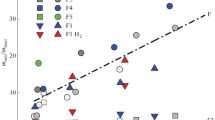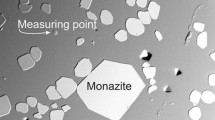Abstract
The saturation surface of pseudobrookite (Fe2TiO5) was determined for melts in the system SiO2-Al2O3-K2O-FeO-Fe2O3-TiO2 at 1400° C and 1 atm. The variation in concentrations of Fe2O3, TiO2 and Fe2TiO5 in liquids can be used to infer relative changes in activity coefficients of these components with changing K2O/(K2O+Al2O3) of the melts. Saturation concentrations of these components are low and relatively constant in the peraluminous melts and increase with increasing K2O/(K2O+Al2O3) in peralkaline liquids. The activity coefficients of Fe2O3 and TiO2 and Fe2TiO5, therefore, are higher in peraluminous liquids than in peralkaline liquids in this system. In addition, the iron redox ratio was measured as a function of K2O/(K2O+Al2O3) for liquids just below the saturation surface; \(f_{{\text{O}}_{\text{2}} }\) was fixed so all variations in redox ratio are entirely due to changes in melt composition. The redox ratio from unsaturated liquids was applied to saturated liquids where redox analysis of the glass is impossible. The homogeneous equilibrium experiments indicate that the activity coefficient of Fe2O3 relative to that of FeO is significantly greater in peraluminous melts than peralkaline melts. Both the heterogeneous and homogeneous equilibria suggest that in peralkaline liquids K+in excess of that required to charge balance tetrahedral Al+3 is used to stabilize both Fe+3 and Ti+4. Calculations show that ferric iron and titanium compete equally effectively for charge-balancing potassium but neither can outcompete aluminum. The observed changes in solution properties of Fe2O3 and TiO2 in the synthetic melts are used to explain variations in Fe-Ti oxide stabilities in natural peraluminous and peralkaline rhyolites and granites. Since the activity coefficients of both ferric iron and titanium are significantly higher in peraluminous liquids than in peralkaline liquids, Fe-Ti oxides should occur earlier in the crystallization sequence in peraluminous rhyolites than in peralkaline rhyolites. In addition, iron will be reduced in peraluminous granites and rhyolites relative to peralkaline ones under comparable P, T, and \(f_{{\text{O}}_{\text{2}} }\). Finally, observed crystallization patterns for minerals containing highly charged cations other than ferric iron and titanium are evaluated in the context of this and other experimental studies.
Similar content being viewed by others
Reference
Barberi F, Ferrara G, Santacroce R, Treuil M, Varet J (1975) A transitional basalt-pantellerite sequence of fractional crystallization, the Boina Centre (Afar Rift, Ethiopia). J Petrol 16:22–56
Bowden P (1974) Oversaturated alkaline rocks: granites, pantellerites, and comendites. In: Sorensen H (ed) The alkaline rocks. Wiley, New York, pp 109–123
Chappell BW, White AJR (1974) Two contrasting granite types. Pac Geol 8:173–174
Clemens JD, Wall VJ (1984) Origin and evolution of a peraluminous silicic ignimbrite suite: the Violet Town volcanics. Contrib Mineral Petrol 88:354–371
Deer WA, Howie RA, Zussman J (1966) An introduction to the rock forming minerals. Longman Grp, London, p 515
Dickenson MP, Hess PC (1981) Redox equilibria and the structural role of iron in alumino-silicate melts. Contrib Mineral Petrol 78:353–357
Dickenson MP, Hess PC (1983) Fe redox equilibria and the structural role of P+5, Ti+4 and Fe+3. EOS Trans AGU (Abstr) 64:350
Dickenson MP, Hess PC (1986) The structural role and homogeneous redox equilibria of iron in peraluminous, metaluminous and peralkaline silicate melts. Contrib Mineral Petrol 92:207–217
Dickinson JE, Hess PC (1985) Rutile solubility and titanium coordination in silicate melts. Geochim Cosmochim Acta 49:2289–2296
Ellison AJ, Hess PC (1986) Solution behavior of +4 cations in high silica melts: petrologic and geochemical implications. Contrib Mineral Petrol 94:343–351
Ellison AJG, Hess PC (1988) Peraluminous and peralkaline effects on “monazite” solubility in high-silica liquids. EOS Trans AGU (Abstr) 69:498
Engelhardt G, Nofz M, Forkel K, Wihsmann FG, Mägi M, Samoson A, Lippmaa E (1985) Structural studies of calcium aluminosilicate glasses by high resolution solid state 29Si and 27Al magic angle spinning nuclear magnetic resonance. Phys Chem Glasses 26:157–165
Ewart A (1981) The mineralogy and chemistry of the anorogenic Tertiary silicic volcanics of S.E. Queensland and N.E. New South Wales, Australia. J Geophys Res 86:10242–10256
Fox KE, Furukawa T, White WB (1982) Transition metal ions in silicate melts. Part 2. Iron in sodium silicate glasses. Phys Chem Glasses 23:169–178
Greegor RB, Lytle FW, Sandstrom DR, Wong J, Schultz P (1983) Investigation of TiO2-SiO2 glasses by X-ray absorption spectroscopy. J Non Cryst Solids 55:27–43
Harris C (1983) The petrology of lavas and associated plutonic inclusions of Ascension Island. J Petrol 24:424–470
Hess PC (1988) The role of high field strength cations in silicate melts. In: Advances in physical chemistry. Springer, New York Berlin Heidelberg (in press)
Kilinc A, Carmichael ISE, Rivers ML, Sack RO (1983) The ferric-ferrous ratio of natural silicate liquids equilibrated in air. Contrib Mineral Petrol 83:136–140
Macdonald R (1974) Nomenclature and petrochemistry of the peralkaline oversaturated extrusive rocks. Bull Volcanol 8:498–516
Montel JM (1986) Experimental determination of the solubility of Ce-monazite in SiO2-Al2O3-K2O- Na2O melts at 800° C, 2 kbar under H2O-saturated conditions. Geology 14:659–662
Morsi MM, El-Shennawi AWA (1984) Some physical properties of silicate glasses containing TiO2 in relation to their structure. Phys Chem Glasses 25:64–68
Naski G, Hess PC (1984) SnO2 solubility: experimental results in peraluminous and peralkaline high silica glasses. EOS Trans AGU (Abstr) 66:412
Nicholls J, Carmichael ISE (1969) Peralkaline acid liquids: a petrological study. Contrib Mineral Petrol 20:268–294
Paul A, Douglas RW (1965) Ferrous-ferric equilibrium in alkali silicate glasses. Phys Chem Glasses 6:207–211
Rutherford MJ (1969) An experimental determination of iron biotite-alkalie feldspar equilibria. J Petrol 10:381–408
Ryerson FJ, Watson EB (1987) Rutile saturation in magmas: implications for Ti-Nb-Ta depeletion in island-arc basalts. EPSL 86:225–239
Sandstrom DR, Lytle FW, Wei PSP, Greegor RB, Wong J, Schultz P (1980) Coordination of Ti in TiO2-SiO2 glass by X-ray absorption spectroscopy. J Non Cryst Solids 41:201–207
Skoog DA, West DM (1982) Fundamentals of analytical chemistry. CBS College Publishing, New York, pp 39–90
Sutherland DS (1974) Petrography and mineralogy of the peralkaline silicic rocks. Bull Volcanol 8:517–541
Thornber CR, Roeder PL, Foster JR (1980) The effect of composition on the ferric-ferrous ratio in basaltic liquids at atmospheric pressure. Geochim Cosmochim Acta 44:525–532
Virgo D, Mysen BO, Danckwerth P, Seifert F (1982) Speciation of Fe +3in 1-atm Na2O-SiO2-Fe-O melts. Carnegie Inst Wash Yearb 81:349–353
Watson EB (1979a) Zircon saturation in felsic liquids: experimental results and applications to trace element geochemistry. Contrib Mineral Petrol 70:407–419
Watson EB (1979b) Apatite saturation in basic to intermediate magmas. Geophy Res Lett 6:937–940
Watson EB, Harrison TM (1983) Zircon saturation revisited: temperature and composition effects in a variety of crustal magma types. Earth Planet Sci Lett 64:295–304
Whalen JB, Currie KL, Chappell BW (1987) A-type granites: geochemical characteristics, discrimination and petrogenesis. Contrib Mineral Petrol 95:407–419
Wolff JA, Storey M (1984) Zoning in highly alkaline magma bodies. Geol Mag 121:563–575
Wyborn D, Chappell BW, Johnston RM (1981) Three S-type volcanic suites from the Lachlan Fold Belt, southeast Australia. J Geophys Res 86:10335–10348
Yarker CA, Johnson PAV, Wright AC, Wong J, Greegor RB, Lytle FW, Sinclair RN (1986) Neutron diffraction and EXAFS evidence for TiO5 units in vitreous K2O-TiO2 SiO2. J Non Cryst Solids 79:117–136
Author information
Authors and Affiliations
Rights and permissions
About this article
Cite this article
Gwinn, R., Hess, P.C. Iron and titanium solution properties in peraluminous and peralkaline rhyolitic liquids. Contr. Mineral. and Petrol. 101, 326–338 (1989). https://doi.org/10.1007/BF00375317
Received:
Accepted:
Issue Date:
DOI: https://doi.org/10.1007/BF00375317




